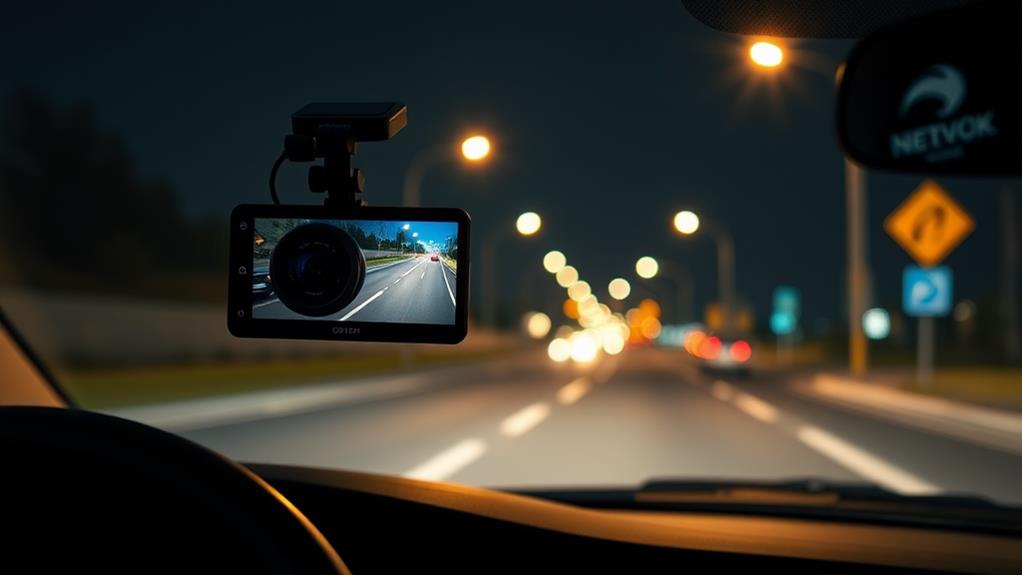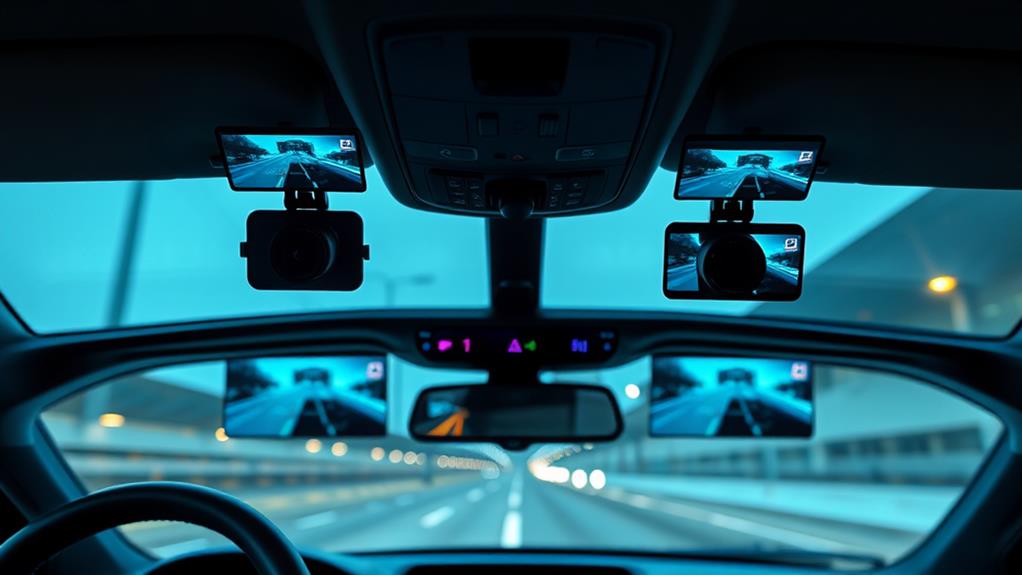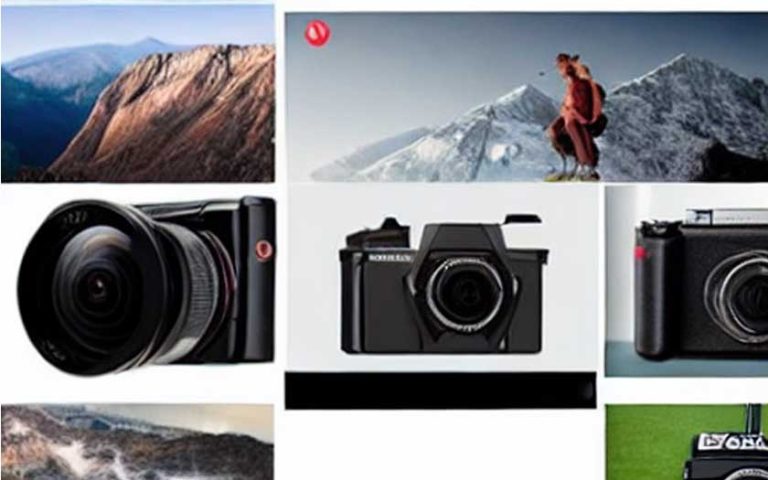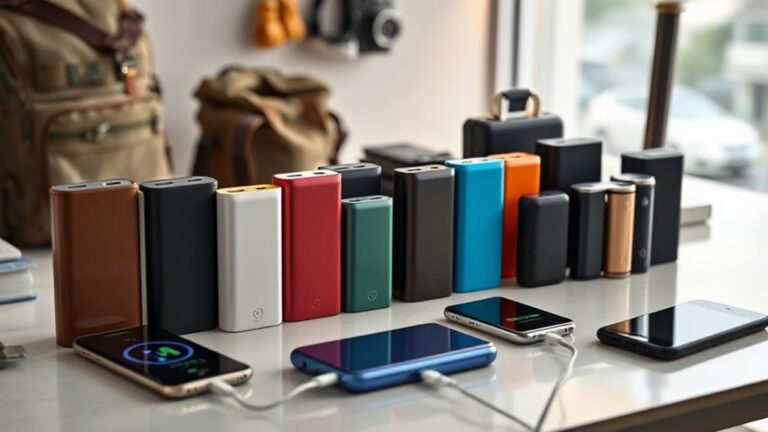Links below are affiliate links. We earn a commission on purchases at no extra cost to you. Although our opinions are based on curated research, we have not used these products. Article generated with AI.
The top dashcams of [yeat] offer impressive features to capture your journeys with clarity. You’ll find models like the REDTIGER 4K/2.5K Dual Dash Cam, E-YEEGER 2.5K WiFi Dash Cam, Sarmert C1 5K Dash Cam, a 4K+1080P Front and Rear Dash Cam, and the Miden S7 2.5K Dual Dash Cam. These devices boast high-resolution recording, wide-angle lenses, and low-light performance enhancements. Many include Wi-Fi connectivity, GPS tracking, and smartphone app integration for easy footage management. When choosing a dashcam, consider video quality, field of view, storage capacity, and additional features like parking mode or collision detection. The following information will help you make an informed decision about which dashcam best suits your needs.
Highlights
- REDTIGER 4K/2.5K Dual Dash Cam offers exceptional video quality with 4K front and 2.5K rear recording.
- E-YEEGER 2.5K WiFi Dash Cam features Super Night Vision technology for improved low-light footage clarity.
- Sarmert C1 5K Dash Cam captures ultra-high-resolution video at 5120x2160P with a 150° ultra-wide angle lens.
- Dash Cam Front and Rear 4K+1080P provides dual-channel recording with 4K front and 1080P rear resolution.
- Miden S7 2.5K Dual Dash Cam includes a 10-year warranty and lifetime technical support for long-term reliability.
REDTIGER 4K/2.5K Dual Dash Cam with Wi-Fi GPS
REDTIGER 4K/2.5K Dual Dash Cam with Wi-Fi GPS
Experience unmatched clarity with the REDTIGER F7NP dash cam, recording in Ultra HD 4K and FHD 1080P. With superior night vision, GPS tracking, and smart app controls, it ensures you’re always covered on the road.
…
The REDTIGER 4K/2.5K Dual Dash Cam is a tech-savvy driver’s dream, offering crystal-clear 4K front and 2.5K rear recording. With wide-angle lenses capturing 170 degrees in front and 140 degrees in back, you’ll have extensive coverage of your surroundings.
The dash cam excels in low-light conditions, thanks to its F1.5 aperture and HDR/WDR technology. Built-in GPS tracks your route, speed, and location, while loop recording guarantees continuous footage capture. You can easily access and manage your videos through the Wi-Fi-enabled smartphone app, compatible with both iOS and Android devices.
The included 32GB memory card gets you started, but consider upgrading to a 256GB card for extended recording time. For 24-hour parking surveillance, you’ll need to purchase an additional hardwire kit.
Best For: Drivers seeking a high-quality, feature-rich dash cam with dual-channel recording, GPS tracking, and easy smartphone integration for enhanced driving safety and incident documentation.
Pros:
- Exceptional video quality with 4K front and 2.5K rear recording
- Superior night vision capabilities with F1.5 aperture and HDR/WDR technology
- User-friendly interface with Wi-Fi connectivity and smartphone app for easy video management
Cons:
- Additional purchase required for hardwire kit to enable 24-hour parking mode
- The 32GB memory card included may be insufficient for extended recording needs
- Limited documentation for installation and parking mode setup
E-YEEGER 2.5K WiFi Dash Cam for Cars with App
E-YEEGER 2.5K WiFi Dash Cam for Cars with App
The E-YEEGER V100 dash cam offers 2.5K Ultra HD recording, advanced night vision, and WiFi app control. Its compact, durable design and 24/7 surveillance ensure safety on the road at all times.
…
Rideshare drivers and safety-conscious motorists will find the E-YEEGER 2.5K WiFi Dash Cam an ideal choice for 2024. This compact device offers 2.5K Ultra HD recording with a 160° wide-angle lens, capturing up to four traffic lanes with exceptional clarity.
Its Super Night Vision technology enhances low-light footage, increasing light intake by 30%. The dash cam’s WiFi connectivity and app control allow you to stream live footage, review recordings, and adjust settings easily.
The E-YEEGER comes with a pre-installed 32GB SD card and supports up to 256GB of storage. It uses H.265 encoding to save memory space without compromising quality. The device’s durable design, featuring a heat-resistant chipset and aluminum alloy shell, guarantees reliability in extreme temperatures.
Users praise its exceptional video quality, easy installation, and valuable features like the G-Sensor, which secures critical footage during sudden movements or impacts.
Best For: Rideshare drivers, daily commuters, and safety-conscious motorists seeking high-quality video documentation and enhanced security features in their vehicles.
Pros:
- Exceptional 2.5K Ultra HD video quality with 160° wide-angle coverage
- User-friendly WiFi connectivity and app control for easy access to footage
- Durable design with advanced features like Super Night Vision and G-Sensor
Cons:
- May require an additional purchase for larger SD card storage
- Potential learning curve for users unfamiliar with dashcam technology
- Continuous WiFi usage might impact mobile device battery life
Sarmert C1 5K Dash Cam with Built-in GPS and WiFi
Sarmert C1 5K Dash Cam with Built-in GPS and WiFi
Capture every moment with the Sarmert C1 5K dash cam. With stunning 5K video quality, advanced night vision, GPS features, and built-in 5G WiFi, it’s the ultimate companion for your journeys!
…
Drivers seeking crystal-clear footage and advanced features will find the Sarmert C1 5K Dash Cam an impressive choice. This device captures video at an exceptional 5120x2160P resolution, with options for 4K and 2.5K recording to balance quality and file size.
Its advanced night vision capabilities, including a high-sensitivity sensor and f1.8 aperture, guarantee clear images in low light conditions. The 150° ultra-wide angle lens reduces blind spots, while WDR technology stabilizes footage in varying light conditions.
The Sarmert C1 boasts built-in dual-band WiFi, allowing seamless connection to smartphones via the RoadRec app for easy video management and settings adjustments. Its integrated GPS records driving routes, location, and speed, viewable through the app or Sarmert’s GPS Player.
Additional features include loop recording, G-sensor accident detection, and a 24-hour parking monitor. With support for microSD cards up to 512GB and a compact design with a 2-inch IPS screen, this dash cam offers both functionality and user-friendliness.
Best For: Drivers who prioritize high-resolution video quality, advanced features, and seamless connectivity in their dash cam experience.
Pros:
- Exceptional 5K video resolution with multiple quality options
- Built-in GPS and dual-band WiFi for easy connectivity and location tracking
- Comprehensive features including night vision, parking mode, and wide-angle lens
Cons:
- May require a high-capacity microSD card for extended recording time
- Additional hardwire kit needed for 24-hour parking monitor functionality
- Potentially overwhelming for users seeking a simple, basic dash cam
Dash Cam Front and Rear 4K+1080P with Built-in WiFi
Dash Cam Front and Rear 4K+1080P with Built-in WiFi
Upgrade your driving safety with the ARIFAYZ Q4 dash cam featuring 4K+1080P resolution. Capture every detail with ease, enjoy seamless app control, and ensure protection even when parked.
…
Capturing crystal-clear footage in both 4K and 1080P, the ARIFAYZ Q4 Dash Cam is ideal for drivers who want top-tier video quality and extensive coverage. This dual-channel system records the front view in 4K 2160P with a 160° angle and the rear in 1080P with a 150° angle.
The GC CMOS sensor guarantees sharp detail of license plates and road signs, even in low-light conditions. With built-in 2.4G WiFi, you can live stream, download, and share videos using the dedicated app for Android and iOS.
Installation is straightforward, with a compact design that mounts discreetly behind your rearview mirror. The dash cam offers excellent night vision capabilities and a 24-hour parking mode that activates automatically when parked.
Users praise the video quality, ease of use, and responsive customer support. For its price point, this dash cam provides exceptional value, making it a worthy investment for enhancing driving safety.
Best For: Drivers seeking high-quality video coverage, easy installation, and convenient WiFi connectivity for enhanced safety and incident documentation.
Pros:
- Dual-channel system with 4K front and 1080P rear recording
- Built-in WiFi for easy video access and sharing via smartphone app
- Excellent night vision and 24-hour parking mode for comprehensive protection
Cons:
- May require professional installation for optimal wiring concealment
- Higher price point compared to basic dash cam models
- 4K recording may consume more storage space, requiring frequent SD card management
Miden S7 2.5K Dual Dash Cam with 64GB SD Card
Miden S7 2.5K Dual Dash Cam with 64GB SD Card
Upgrade your driving experience with the Miden S7 dash cam. Featuring 2.5K front and FHD rear recording, 3.2-inch screen, and robust safety features, it’s your ultimate road companion.
…
The Miden S7 2.5K Dual Dash Cam stands out for drivers who want extensive coverage without breaking the bank. This dual-camera system captures both front and rear views, with the front camera offering 2.5K resolution and a 176° wide-angle lens, while the rear camera provides 1080P quality with a 160° field of view. You’ll appreciate the 3.2-inch IPS screen for easy navigation and the included 64GB SD card for ample storage.
The S7 comes equipped with essential features like loop recording, G-sensor for collision detection, and night vision capabilities. It’s designed for user-friendly installation and operation, with a compact form that won’t obstruct your view.
Customers report high satisfaction with video quality and reliability, particularly in low-light conditions. With a 10-year warranty and lifetime technical support, you’re investing in a long-term solution for your driving documentation needs.
Best For: Drivers seeking comprehensive front and rear coverage with high-resolution video quality and user-friendly features at an affordable price point.
Pros:
- High-quality dual-camera system with 2.5K front and 1080P rear resolution
- Packed with essential features like night vision, G-sensor, and loop recording
- Comes with a 64GB SD card and 10-year warranty for long-term value
Cons:
- May require professional installation for optimal rear camera placement
- 3.2-inch screen size might be small for some users
- Lacks advanced features like GPS tracking or cloud storage capabilities
Factors to Consider When Choosing Dashcams

When you’re in the market for a dashcam, there are several key factors you’ll need to contemplate. Your choice should take into account video resolution and quality, field of view, storage capacity, night vision capabilities, and connectivity features. These elements will determine how well your dashcam performs in various driving conditions, how much footage it can store, and how easily you can access and share your recordings.
Video Resolution and Quality
Video resolution and quality stand at the forefront of dashcam selection criteria. When choosing a dashcam, you’ll want to take into account the resolution options available. While 1080P has been the standard, higher resolutions like 2.5K and 4K offer remarkably more detail.
A 2.5K resolution provides about 70% more detail than 1080P, striking a balance between quality and storage needs. If you’re after the clearest images of license plates and road signs, 4K resolution delivers the highest level of detail.
Night vision capabilities are essential for maintaining video quality in low-light conditions. Look for features like F1.5 aperture and WDR technology, which enhance clarity during nighttime driving. The field of view is another important factor; wider angles, such as 170 degrees or more, reduce blind spots and capture more of your surroundings.
Additionally, think about dashcams that incorporate advanced encoding technologies like H.265. This allows for high-quality video recording while conserving storage space, enabling longer recording times without sacrificing resolution. By weighing these factors, you can select a dashcam that provides the best video quality for your needs.
Field of View
Regarding dashcam selection, the field of view (FOV) plays an important role in determining the camera’s effectiveness. The FOV refers to the extent of your surroundings that the camera can capture, with wider angles offering better overall visibility and fewer blind spots.
For front-facing cameras, you’ll typically find FOVs ranging from 120 to 170 degrees, while rear cameras generally offer 140 to 160 degrees. When choosing a dashcam, it’s recommended to opt for a FOV of at least 130 degrees to guarantee adequate coverage of the road and nearby areas.
A wider FOV is particularly beneficial in multi-lane environments, as it allows you to capture more lanes of traffic. This can be vital for documenting incidents or accidents. If you’re looking for extensive coverage, consider a dual-channel setup with both front and rear cameras.
This configuration expands your overall FOV, providing more complete video evidence if needed. Remember, while a wider FOV can be advantageous, it’s important to balance this with other factors such as video quality and resolution to make sure you’re getting the best possible footage for your needs.
Storage and Recording Capacity
Storage and recording capacity are vital factors in choosing the right dashcam for your needs. While most dashcams come with pre-installed 32GB SD cards, you’ll want to take into account models that support larger capacities, up to 256GB or even 512GB, for extended recording time. Loop recording is an important feature you should look for, as it automatically overwrites the oldest footage when the memory is full, guaranteeing continuous capture without your intervention.
To maximize your storage efficiency, opt for dashcams that use H.265 encoding. This technology can save up to 50% more memory space while maintaining high video quality, allowing for longer recording durations.
Don’t forget to evaluate the dashcam’s resolution, as higher resolutions like 4K will require considerably more space than lower ones such as 1080P. Additionally, a G-Sensor feature is essential for detecting collisions and automatically locking important footage, preventing it from being overwritten during loop recording.
By carefully assessing these storage and recording aspects, you’ll make certain your dashcam can capture and retain all the important moments of your journeys.
Night Vision Capabilities
In light of the increasing popularity of dashcams, night vision capabilities have become an essential element to take into account when making your purchase. These features greatly enhance your ability to capture clear footage in low-light conditions, ensuring you don’t miss any important details during nighttime driving.
When evaluating night vision capabilities, you’ll want to look for dashcams with advanced features like an F1.5 aperture and high-quality sensors. These components work together to improve image clarity in dark environments.
Additionally, technologies such as Wide Dynamic Range (WDR) help stabilize footage and balance exposure, making details visible in both bright and dark areas of the video. Some models even incorporate Super Night Vision technology, which can increase light intake by up to 30%, resulting in clearer nighttime images compared to standard dashcams.
The quality of the camera’s lens also plays a key role, with multiple glass lenses typically offering better low-light performance. Finally, consider opting for a higher resolution, such as 2.5K or 4K, as this can further enhance the detail captured in dark environments, providing you with more thorough nighttime footage.
Connectivity and App Features
While night vision capabilities are important for capturing clear footage in low-light conditions, connectivity, and app features play a key role in maximizing your dashcam’s functionality. When selecting a dashcam, prioritize models with built-in WiFi connectivity. This feature enables seamless streaming, downloading, and sharing of footage directly to your smartphone or tablet, enhancing the device’s versatility.
Verify the dashcam you choose is compatible with both iOS and Android devices, offering a user-friendly app for easy video management and settings adjustments. Look for advanced app features such as live footage streaming, GPS tracking, and evidence sharing for insurance claims. These capabilities can considerably improve the overall utility of your dashcam.
Some dashcams support over-the-air (OTA) updates via their apps, allowing you to keep your device’s software current without requiring physical access. This feature guarantees your dashcam remains up-to-date with the latest improvements and security patches.
Additionally, a responsive app experience can greatly enhance user satisfaction by simplifying tasks like formatting SD cards and accessing recorded footage. When evaluating dashcams, consider the quality and functionality of their companion apps as a vital factor in your decision-making process.
Installation and Design
A dashcam’s design and installation process can considerably impact its effectiveness and your overall satisfaction. When choosing a dashcam, look for compact models that mount discreetly without obstructing your view. This design feature enhances safety while driving and guarantees the camera doesn’t become a distraction.
Consider dashcams that come with all necessary installation accessories. This inclusion makes the setup process easier, especially if you’re a first-time user. User-friendly interfaces and clear display screens are also vital, as they facilitate easy navigation and setting adjustments during installation.
The mounting mechanism’s sturdiness is another key factor. A well-designed mount prevents vibrations and shifts during drives, maintaining consistent video quality. Additionally, evaluate the ease of wiring concealment. A well-designed system should allow for a clean, unobtrusive installation in your vehicle.
When reviewing dashcam options, prioritize models that balance functionality with ease of installation. Look for features like plug-and-play setups or detailed installation guides. Remember, a dashcam that’s difficult to install or poorly designed may end up being more of a hindrance than a help on the road.
Frequently Asked Questions
Are Dashcams Legal in All States and Countries?
Dashcam legality varies by location. In the United States, they’re generally legal, but some states have restrictions on windshield mounting or audio recording. Internationally, laws differ considerably. For example, Austria and Switzerland prohibit dashcams, while the UK allows them with certain guidelines. You’ll need to check local laws before using a dashcam, as regulations can change. Consider privacy concerns, consent requirements, and potential restrictions on sharing footage. Always prioritize road safety and comply with local regulations when using dashcams.
How Long Does the Average Dashcam Battery Last?
You’ll find that the average dashcam battery life varies considerably. Most built-in batteries last between 15 to 30 minutes, primarily designed for parking mode or emergency backup. However, if you’re looking for extended recording, you’ll need to connect your dashcam to your car’s power source. Some high-end models feature capacitors instead of batteries, which can withstand extreme temperatures better. It’s essential to acknowledge that battery life depends on usage, temperature, and the specific model you choose.
Can Dashcam Footage Be Used as Evidence in Court?
As swift as a camera’s shutter, dashcam footage can indeed be used as evidence in court. You’ll find that many legal systems accept this type of video as admissible evidence. It’s often used in cases involving traffic accidents, road rage incidents, or insurance claims. However, you should be aware that the footage’s admissibility can depend on factors like its quality, relevance to the case, and how it was obtained. Always consult with a legal professional for specific guidance.
Do Dashcams Record Audio Along With Video?
Many dashcams do record audio along with video, but it’s not a universal feature. You’ll find that most modern models offer this capability, allowing you to capture both visual and auditory information during your drives. However, it’s important to check the specific features of any dashcam you’re considering. Some models may have audio recording disabled by default, requiring you to activate it manually. Always be aware of local laws regarding audio recording, especially when it involves passengers or other individuals.
How Often Should Dashcam Memory Cards Be Replaced?
You should replace your dashcam’s memory card regularly, typically every 6-12 months. Frequent writing and overwriting can degrade the card’s performance and reliability. However, the exact replacement frequency depends on your usage patterns and the card’s quality. High-endurance cards, designed for continuous recording, may last longer. Monitor your footage quality, and if you notice glitches or missing segments, it’s time for a replacement. Always format new cards in the dashcam before use for peak performance.









